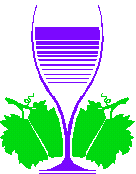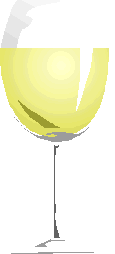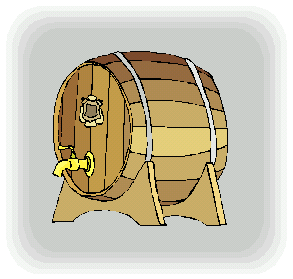The advancing winemaker as well as the
beginning winemaker will want to analyze certain compounds and chemicals
in their wine. The list here is by no means exhaustive, but will allow
the home winemaker, to measure and understand some of the chemical tests
involved with making wine. Some of these tests will be beyond the scope
of the small lot home winemaker, as certain unobtainable chemicals are
involved, but there are other tests listed here that are at very necessary
in making a good balanced wine
Desirable Chemical Tests:
- Sugar Content Of Must Or Juice
- Total Acidity Of Must Or Juice
- Residual Sugar In Wine
- Percent Alcohol In Wine
Advanced Chemical Tests:
- Sulfur Dioxide (S02)
- Malolactic Fermentation Detection
Sugar
Content Of Must Or Juice
 As
was explained in the step by step section, you will use a hydrometer to
perform this test. Most hydrometers are calibrated at around 68 degrees,
so will want you juice or must to ba as close to this temperature as
possible. As
was explained in the step by step section, you will use a hydrometer to
perform this test. Most hydrometers are calibrated at around 68 degrees,
so will want you juice or must to ba as close to this temperature as
possible.
- Fill the hydrometer cylinder or flask with juice or must, avoid
bubbles
- Place the hydrometer into the cylinder and spin slightly
- Allow hydrometer to float in liquid without touching the sides
of the cylinder
- Read the scale on the hydrometer at the meniscus level
- A triple scale hydrometer will read in specific gravity, sugar
per ounces, and potential alcohol.
Total
Acidity
This is a very essential test for making a balanced wine. Acid
effects wine an many ways. It is very helpful in keeping bacteria at
bay, and at helping wine to maintain its color. When acid is dissolved
in a liquid it separates into two parts. The parts are the hydrogen ion
(H+) and the anion (A-) The separation of acid is known as
dissociation. The individual parts can then recombine into
un-dissociated acid (HA) This is the acid that will have the
effect on the taste of wine.
- Reagents Needed:
- Sodium Hydroxide (NaOH)
- Phenolphthalein Indicator Solution
 White
Wine White
Wine
- Add 5ml of juice or wine to 75ml of distilled water
- add 5 drops of indicator solution, shake well
- Titrate with NaOH until a color change. (Pinkish Color)
- The amount of NaOH used times .15 equals grams of acid per 100
ml of juice or wine. Also can be calculated in percent tartaric by
moving the decimal point of the final reading one place to the
left.
 Red
Wine Red
Wine
- Add 5ml of wine to 75ml of distilled water
- do not add indicator instead, titrate with NaOH until the
solution turns a blue-green color
- Add 5 drops of indicator solution
- Resume titration with NaOH until the color change end point
(Pinkish Color)
Residual
Sugar
This can be a very elaborate test, and some wineries do take
intricate chemical tests to determine this value. For the home winemaker
the use of a dextrocheck kit will suffice. I have calculated percentages
in place of specific gravity before, and just winged it on the residual
sugar percentage for a competition before. Dextrocheck
Kit:
- Decolorize your wine with charcoal
- Add 1 reagent tablet to 0.5 ml sample of decolorized wine
- After tablet has dissolved, read color against the scaled
provided with kit.
Percent
Alcohol
Just
Do The Math = Starting specific gravity minus Final
specific gravity Divided by .0074 = percent alcohol in finished wine
Example. 1.090 - .995 = .095 / .0074 = 12.8% alcohol
Another Way, Starting percent sugar
minus finished percent sugar multiplied by 0.57
Sulfur Dioxide
 This
is an advanced chemical test, and is beyond the scope of most home
winemakers. Some wine supply shops now carry simplified titrette tests
that can be done by the home vintner, but I am not sure how accurate
these tests are. Sulfur dioxide (S02) in wine is eventually converted to
sulfuric acid, and the simpler tests use this osmoses to calculate S02
levels in a wine. The advanced method of determining the S02 levels in
wine is called the ripper method, and a brief description of this method
is as follows. This
is an advanced chemical test, and is beyond the scope of most home
winemakers. Some wine supply shops now carry simplified titrette tests
that can be done by the home vintner, but I am not sure how accurate
these tests are. Sulfur dioxide (S02) in wine is eventually converted to
sulfuric acid, and the simpler tests use this osmoses to calculate S02
levels in a wine. The advanced method of determining the S02 levels in
wine is called the ripper method, and a brief description of this method
is as follows.
Reagents Needed:
Malolactic Fermentation
|

